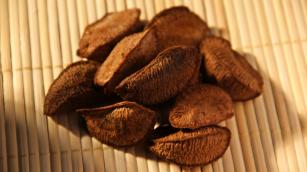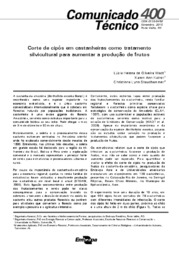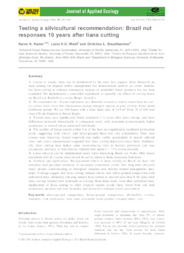Liana cutting in Brazil nut trees can increase production in up to 30%
Liana cutting in Brazil nut trees can increase production in up to 30%
Results of ten years of research indicates that Brazil nut trees that received the forestry treatment of liana cutting produced a third more Brazil nuts than those that had not been treated. The perceptions of some foragers was proven by research, which quantified and created parameters for such low cost treatment, with the aim of ensuring more production gains and income to Amazon natural resource extraction workers.
In addition to the 30% increase in the production of fruits from the Brazil nut trees with the liana cutting, the work also demonstrated that this effect was observed five years after the cutting. The scenario was that, after the lianas were cleared, the Brazil nut trees recovered their crowns, and some that had never born fruit started producing them. Other trees that were heavily infested by lianas and that were not treated died, while those that received the management recovered.
In the Extractive Reserve Cazumbá-Iracema, in Sena Madureira, Acre, results from liana cutting have already been noticed. “Some infested Brazil nut trees did not produce anything. We followed the orientation to cut the lianas and there are trees that are already producing up to five cans of Brazil nut shells”, states the president of the Cazumbá Base Team, the resource extraction worker Alfonso Da Silva.
Based on the research, scientists recommend only removing the lianas that infest the tree crowns and that are rooted next to their trunks, within a five to ten meter radius. It is worth nothing that Brazil nut tree liana cutting is an easily-performed low-cost activity, as the cutting can be made at the time of the harvest and, on average, it takes less than a minute to cut a liana.
Production with sustainability
This study, developed by researchers from Embrapa Acre and Embrapa Rondônia, and from the American universities University of Florida and University of Alabama, stands out because it offers quantified information and recommendations of forestry treatments for Brazil nut trees to forest extraction workers. “We have sought techniques to improve productivity in line with the conservation of natural resources. This encourages natural resource extraction workers to continue in the occupation and obtain income by maintaining the forest”, explains the Embrapa Rondônia researcher Lúcia Wadt.
According to her, the recommendations have already been made to different communities that have successfully adopted the practice and been reaching higher gains in their family income. “For research, this is the result that we seek: use science through experimentation to promote significant improvements to workers' income, with due respect to the environment and keeping the forest standing”, she concludes.
One of the locations that adopted the research recommendations was the Porvir rubber tree grove, in Epitaciolândia, Acre, in the Chico Mendes Extractive Reserve. According to the president of the Wilson Pinheiro II Base Team, Severino da Silva Brito, all natural resource extraction workers in the community have already adopted the practice. “My father used to do it, he said that we needed to cut the lianas to stop the nut tree branches from drying, but I did not take much of that in consideration. After the practices with the Embrapa team, people started to have that habit. There was a Brazil nut tree that beat the record. It produced half a can of nut shells, then we pruned the lianas and, two years later, we collected six cans. Nowadays, there are no nut trees with lianas in my area. I say that those who have nut tree groves must cut the lianas to have more Brazil nuts”, he reports.
The research
Due to the importance of Brazil nuts (Bertholletia excelsa Bonpl.) to the natural resource extraction economy, researchers' attention was drawn to the drop in worker family income observed in recent years and attributed to low nut production. The producers reported that the lianas present in the Brazil nut trees lowered fruit production. Then, to test the hypothesis, the scientists carried out an experiment with 138 Brazil nut trees, conducted and assessed for ten years, in the Chico Mendes Extractive Reserve, in Acre state.
In the study, 454 lianas were cut from 78 Brazil nut trees with different intensities of infestation. The liana cutting was performed in two sections, one next to the soil, and the other at a height of two meters above the ground. All the trees of the experiment, both the ones whose lianas were chopped down and those that did not receive the treatment, were monitored once a year to collect data on fruit production and follow liana reinfestations. All the lianas that resprouted or any new infestation in treated nut trees were systematically cut to keep the treated trees liana-free. During the first four years, there was no difference in production between treated and non-treated Brazil nut trees. Good results started to be noticed from the fifth year on, when the trees whose lianas had been cut produced more than the ones that had not had the cutting.
According to the researcher Lúcia Wadt, when analyzing the reason behind the improved production, it was verified that the competition for light in the tree crown area and the competition for water and nutrients in the soil had had effects. Brazil nut trees with less than 25% of their crowns covered with lianas produced more fruits that those that had over 25% of their crowns infested. The amount of lianas rooted close to each nut tree trunk was also important, as the larger the number of lianas next to the trunk, the lower the fruit production.
| Social and economic importance of Brazil nut trees Brazil nuts are the only internationally traded nuts that are collected in natural forests by traditional populations. Moreover, the Brazil nut trees are giant Amazon Forest trees that work as a structure for different species of living beings that inhabit their surroundings. Their trunks can reach more than three meters in diameter, and each plant, 50 meters in height. In 2014, Brazil nuts moved 7.6 million reais in primary production (IBGE, 2016). The vast majority of this production comes from conservation units, indigenous lands and agricultural settlements, and is responsible for most of the income of more than 55,000 people, composed of traditional peoples and communities, and family farmers (MDA; MMA; MDS, 2009). Given its importance to the regional economy, the drop in extraction worker family income observed in recent years was attributed to low nut production. The link between fruit production and income can have direct consequences for forest conservation, because, with low collection, the extraction workers can give the activity up and move on to others that change the forest, such as cattle farming and intensive agriculture. The connections between Brazil nut fruit production, family income, and keeping forests conserved make the Brazil nut tree a key species for Amazon conservation strategies. Despite the economic importance and the conservation of the Bertholletia excelsa species, there are still few studies on production variation and on forestry treatments that can benefit fruit production. . |
Tradução: Mariana de Lima Medeiros
Renata Silva (MTb 12361/MG)
Embrapa Rondônia
rondonia.imprensa@embrapa.br
Phone number: +55 69 3219-5011
Priscila Viudes (Mtb 030/MS)
Embrapa Acre
Further information on the topic
Citizen Attention Service (SAC)
www.embrapa.br/contact-us/sac/





